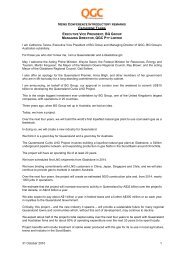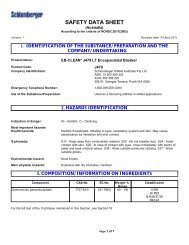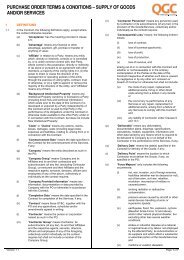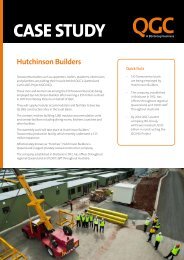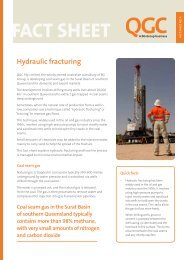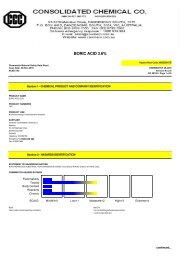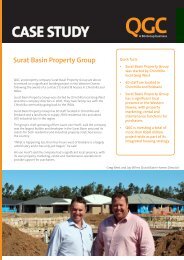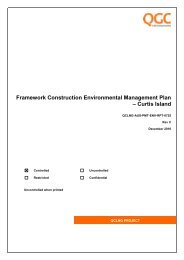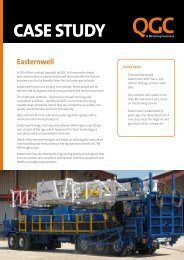Pest and Weed Management Plan - QGC
Pest and Weed Management Plan - QGC
Pest and Weed Management Plan - QGC
You also want an ePaper? Increase the reach of your titles
YUMPU automatically turns print PDFs into web optimized ePapers that Google loves.
<strong>Pest</strong> <strong>and</strong> <strong>Weed</strong> <strong>Management</strong> <strong>Plan</strong>Rev 0May 20112.2 ScopeThis <strong>Pest</strong> <strong>and</strong> <strong>Weed</strong> <strong>Management</strong> <strong>Plan</strong> has been created to collate existing <strong>QGC</strong> procedures <strong>and</strong>management plans for pests <strong>and</strong> weeds into one management document <strong>and</strong> provide additional weed<strong>and</strong> pest management methods. This document satisfies the requirements of Conditions G14 to G16 ofthe Project Environmental Authority (EA) PEN100020207 issued by DERM <strong>and</strong> those of the CoordinatorGeneral, DSEWPC <strong>and</strong> EIS commitments (Appendix 1). It is expected that this document will meet therequirements of any EAs issued for the QCLNG Project. It applies to the Gas Field only.3 <strong>Weed</strong>s3.1 Relevant LegislationIn Queensl<strong>and</strong>, the L<strong>and</strong> Protection (<strong>Pest</strong> <strong>and</strong> Stock Route <strong>Management</strong>) Act 2002 (LP Act) <strong>and</strong> theL<strong>and</strong> Protection (<strong>Pest</strong> <strong>and</strong> Stock Route <strong>Management</strong>) Regulation 2003 (LP Reg) are the relevantlegislation regarding weeds. The LP Act <strong>and</strong> the LP Reg. provide legislative measures to manage pests<strong>and</strong> address the impacts they have on the economy, the environment <strong>and</strong> society. The DEEDIadministers the pest provisions of the Act <strong>and</strong> its regulation.There are three classes of declared plants under the LP Act. These plants are targeted for controlbecause they have, or could have, serious economic, environmental or social impacts. Class 1, 2 <strong>and</strong> 3declared weeds that are likely to occur in the Gas Fields are listed in Appendix 3. Class 1 weeds are not commonly present in Queensl<strong>and</strong> <strong>and</strong>, if introduced, would cause anadverse economic, environmental or social impact. Class 1 pests established in Queensl<strong>and</strong> aresubject to eradication from the state, if such a pest is sighted it must be reported to DEEDI. Class 2 pests are established in Queensl<strong>and</strong> <strong>and</strong> have, or could have, an adverse economic,environmental or social impact. L<strong>and</strong>owners must take reasonable steps to keep their l<strong>and</strong> freeof Class 2 pest. Class 3 pests are well established in Queensl<strong>and</strong> <strong>and</strong> have an adverse economic, environmentalor social impact. L<strong>and</strong>owners are not required to control Class 3 pests unless the l<strong>and</strong> isadjacent to an environmentally significant area. There are a number of environmentallysignificant areas in <strong>and</strong> around the <strong>QGC</strong> Gas Field tenements as shown in the <strong>QGC</strong> Gas Fields<strong>and</strong> Significant Areas map contained in Appendix 2.Under the Local Law provisions of the Local Government Act 1993, a local government can declare anyplants not declared under the LP Act <strong>and</strong> enforce their control. Such plants are often referred to asenvironmental weeds as they can invade native ecosystems <strong>and</strong> adversely affect the survival ofindigenous flora <strong>and</strong> fauna. For example, African Lovegrass, Eragrostris curvula, is not a declared weed,yet is undoubtedly a weed of concern for l<strong>and</strong>holders in the region. Environmental weeds may have12 of 100



